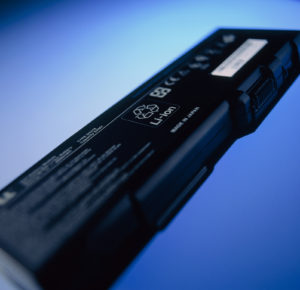Advanced fluoride-based materials in lithium-ion batteries

Lithium-ion batteries are ubiquitous in the modern technology era. Efficient energy storage batteries are in high demand to address the ever-increasing performance of portable electronics and the need for extended range with electric vehicles. Recent research showed that using transition metal fluorides as electrode increased the theoretical capacity of lithium-ion batteries, however its implementation proved to be challenging because of chemical stability issues.
Researchers at Oxford have found a new method to increase the stability of transition metal fluorides in lithium-ion batteries, thus opening new possibilities in energy storage research and applications in areas ranging from consumer electronics to electric transportation.
Energy storage batteries
Lithium-ion batteries have become the industry standard in numerous electrical storage devices from consumer goods such as mobile phones and laptop computers to grid-scale battery units.
Higher energy densities for such applications are always in demand to address the ever-increasing performance of portable electronics and the need for extended range with electric vehicles. Electrode materials made of transition metal fluorides provide a promising candidate for boosting the capacity of lithium ion batteries. They exhibit high theoretical energy densities that can increase capacities to three to five times those of conventional lithium ion battery products.
Whilst transition metal fluorides present a very favourable starting point for new high-capacity and low cycle batteries, there are still limitations in the implementation of this class of chemicals in lithium ion systems. The highly ionic bonding in transition metal fluorides results in low conductivities within batteries, which impacts performance.
Further, when transition metal fluorides are used as electrode materials, they often lose capacity over time due to fusing of individual particles and dissolution of the transition metal, thus impacting its stability.
To address the above challenges, large amounts of carbon and complex fabrication methods can be used with transition metal fluoride cathodes to achieve stable battery cycling behaviour. However, this reduces the practical energy density of such batteries and limits the practical charge/discharge rates that can be achieved.
High performance transition metal fluoride-based batteries
Researchers at the University of Oxford have tackled such limitations and discovered a novel method to increase the stability of transition metal fluorides in lithium ion batteries while avoiding complex fabrication methods.
The new methodology consists of the addition of an ionic liquid electrolyte to the system which allows:
- the formation of an extremely stable protective interphase layer that prevents growth over successive cycles;
- high practical charge/discharge rates; and
- a safer battery system than those based on conventional organic electrolytes.
Initial lithium ion demonstrator systems utilising a metal fluoride cathode and an ionic liquid electrolyte have been generated.
Commercialisation
A patent application directed to the technology has been filed. Oxford University Innovation is now seeking commercial partners to support further development of the technology.
about this technology

